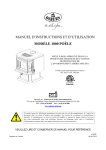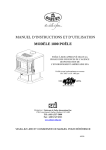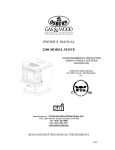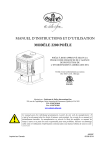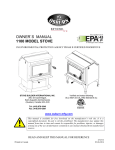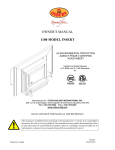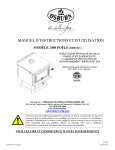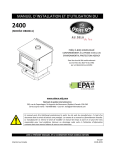Download United States Stove 1800 Owner`s manual
Transcript
OWNER`S MANUAL 1800 MODEL STOVE US ENVIRONMENTAL PROTECTION AGENCY PHASE II CERTIFIED WOODSTOVE Verified and tested following ULC S627 and UL 1482 Standards by: Manufactured by : STOVE BUILDER INTERNATIONAL INC. 250, rue de Copenhague, Saint-Augustin-de-Desmaures (Quebec) G3A 2H3 Tel: ( 418 ) 878-3040 Fax: ( 418 ) 878-3001 www.osburn-mfg.com This manual is available for free download on the manufacturer’s web site. It is a copyrighted document. Re-sale is strictly prohibited. The manufacturer may update this manual from time to time and cannot be responsible for problems, injuries, or damages arising out of the use of information contained in any manual obtained from unauthorized sources. READ AND KEEP THIS MANUAL FOR REFERENCE Printed in Canada 45059A 14-11-2011 INTRODUCTION SBI INC., one of the most important wood stove and fireplace manufacturers in Canada, congratulates you on your purchase and wishes to help you get maximum satisfaction from your wood stove. In the pages that follow, we will give you advice on wood heating and controlled combustion as well as technical specifications regarding installation, operation and maintenance of the model you have chosen. The instructions pertaining to the installation of your wood stove comply with ULC-S627 and UL-1482 standards. We recommend that our woodburning hearth products be installed and serviced by professionals who are certified in the United States by NFI (National Fireplace Institute®) or in Canada by WETT (Wood Energy Technical Training) or in Quebec by APC (Association des Professionnels du Chauffage). Read this entire manual before you install and use your new stove. If this stove is not properly installed, a house fire may result. To reduce the risk of fire, follow the installation instructions. Failure to follow instructions may result in property damage, bodily injury, or even death. Consult your municipal building department or fire officials about restrictions and installations requirements in your area and the need to obtain a permit. Keep this instructions manual for future references. CAUTIONS: THE INFORMATION GIVEN ON THE CERTIFICATION LABEL AFFIXED TO THE APPLIANCE ALWAYS OVERRIDES THE INFORMATION PUBLISHED, IN ANY OTHER MEDIA (OWNER’S MANUAL, CATALOGUES, FLYERS, MAGAZINES AND/OR WEB SITES). HOT WHILE IN OPERATION. KEEP CHILDREN, CLOTHING AND FURNITURE AWAY. CONTACT MAY CAUSE SKIN BURNS. DO NOT USE CHEMICALS OR FLUIDS TO IGNITE THE FIRE. DO NOT LEAVE THE STOVE UNATTENDED WHEN THE DOOR IS SLIGHTLY OPENED. DO NOT BURN WASTES, FLAMMABLE FLUID SUCH AS GASOLINE, NAPHTHA OR MOTOR OIL. DO NOT CONNECT TO ANY AIR DISTRIBUTION DUCT OR SYSTEM. ALWAYS CLOSE THE DOOR AFTER THE IGNITION. REGISTER YOU WARRANTY ONLINE To receive full warranty coverage, you will need to show evidence of the date you purchased your stove. Keep your sales invoice. We also recommend that you register your warranty online at http://www.osburn-mfg.com/warranty-registration.aspx Registering your warranty online will help us track rapidly the information we need on your stove. 2 TABLE OF CONTENTS SECTION 1.0 - INSTALLATION................................................................................................................. 5 1.1 GENERAL INSTALLATION ......................................................................................................................... 5 1.2 CLEARANCES TO COMBUSTIBLES AND FLOOR PROTECTOR........................................................................ 6 1.4 MANUFACTURED (MOBILE) HOME INSTALLATIONS – ADDITIONAL REQUIREMENTS ............................ 13 1.5 CHIMNEY SYSTEM .................................................................................................................................. 13 1.5.1 DEFINITIONS ....................................................................................................................................... 13 1.5.2 COMPONENTS ...................................................................................................................................... 13 1.5.2.1 FACTORY BUILT CHIMNEY SYSTEM ................................................................................................. 14 1.5.2.3 RESIDENTIAL CLOSE CLEARANCES CHIMNEY SYSTEM .................................................................... 14 1.5.3 GENERAL INSTALLATION REQUIREMENTS .......................................................................................... 14 1.5.3.1 CONNECTORS ................................................................................................................................... 15 1.5.3.2 CHIMNEY SYSTEMS .......................................................................................................................... 15 1.5.3.3 EXTERIOR CHIMNEY ........................................................................................................................ 16 1.5.3.4 DRAFT .............................................................................................................................................. 17 1.5.4 TYPICAL TYPES OF CHIMNEY SYSTEMS .............................................................................................. 17 SECTION 2.0 - OPERATION ..................................................................................................................... 19 2.1 SAFETY INFORMATION ........................................................................................................................... 19 2.2 FUEL ...................................................................................................................................................... 20 2.2.1 SIMPLE WOOD MOISTURE TEST .......................................................................................................... 21 2.3 NOTES ABOUT FIRST FIRING .................................................................................................................. 21 2.4 LIGHTING A FIRE ................................................................................................................................... 21 2.5 MAINTAINING THE FIRE ......................................................................................................................... 22 2.6 (OPTIONAL) FAN INSTALLATION AND OPERATION ................................................................................. 23 SECTION 3.0 - MAINTENANCE............................................................................................................... 23 3.1 CARE AND CLEANING ............................................................................................................................ 23 3.1.1 GLASS CLEANING................................................................................................................................ 24 3.2 ASH REMOVAL USING ASH DRAWER ..................................................................................................... 24 3.3 CHIMNEY CLEANING .............................................................................................................................. 25 3.4 BAFFLE INSTALLATION AND BRICK NOTES ............................................................................................ 26 3.5 SECONDARY AIR TUBE REPLACEMENT .................................................................................................. 29 SECTION 4- TROUBLESHOOTING ........................................................................................................ 30 SECTION 5 – SPECIFICATIONS.............................................................................................................. 31 OSBURN LIMITED LIFETIME WARRANTY ....................................................................................... 32 3 4 Section 1.0 - Installation When installed and operated as described in these instructions, the Osburn Model 1800 Bay Wood Stove is suitable for use as a freestanding wood stove in either residential or mobile home installations. The Model 1800 is not intended for installation in a bedroom. In Canada the CSA B365 Installation Code for Solid Fuel Burning Appliances and Equipment and the CSA C22.1 Canadian National Electrical Code are to be followed in the absence of local code requirements. In the USA the ANSI NFPA 70 National Electrical Code and NFPA 211 Standard for Chimneys, Fireplaces, Vents and Solid Fuel-Burning Appliances are to be followed in the absence of local code requirements. In addition to the national installation codes, local building and/or fire officials (or other authorities having jurisdiction) should be contacted to determine what restrictions and installation requirements might locally apply. 1.1 General Installation 1. Proper ventilation is required. 2. Do not connect this unit to any air distribution duct. 3. Connect the stove only to a lined masonry chimney conforming to national and local building codes for use with solid fuel, or to a listed factory built chimney suitable for use with solid fuel. 5 1.2 Clearances to combustibles and floor protector To install your appliance correctly, it is extremely important to respect all clearances to any combustibles as indicated on your stove’s certification label. Clearances to combustible materials (see figure 1.3 to match each letter to a clearance) CLEARANCES (SINGLE WALL PIPE) A B C D E F K L A B C D E F K L CANADA 10" (254 mm) 19" (483 mm) 10" (254 mm) 12" (305 mm) 28" (711 mm) 19" (483 mm) 48" (1220 mm) 84" (213 cm) CANADA 16" (406 mm) 17" (432 mm) 12" (305 mm) 18" (457 mm) 26" (660 mm) 21" (533 mm) 48" (1220 mm) 84" (213 cm) USA 16" (406 mm) 17" (432 mm) 12" (305 mm) 18" (457 mm) 26" (660 mm) 21" (533 mm) 48" (1220 mm) 84" (213 cm) CLEARANCES (DOUBLE WALL PIPE) MOBILE HOME USA 10" (254 mm) 19" (483 mm) 10" (254 mm) 12" (305 mm) 28" (711 mm) 19" (483 mm) 48" (1220 mm) 84" (213 cm) 10" (254 mm) 21" (533 mm) 10" (254 mm) 12" (305 mm) 30" (762 mm) 19" (483 mm) 48" (1220 mm) 84" (213 cm) 6 FIGURE 1.3 Clearances to combustible materials and floor protection 7 Floor protector If the stove is to be installed on top of a combustible floor, it must be guarded by a non combustible material as shown on figure 1.3 (see the dotted line area). FLOOR PROTECTOR* G H I J M N CANADA 8’’ (203 mm) – Note 1 8’’ (203 mm) 18’’ (457 mm) From door opening N/A (USA only) 8’’ (203 mm) N/A (USA only) USA N/A (Canada only) N/A (Canada only) 16’’ (406 mm) From door opening 8’’ (203 mm) N/A (Canada only) Note 2 *Steel with a minimum thickness of 0.015’’ (0.38 mm) or ceramic tiles sealed together with grout. No protection is required if the unit is installed on a non-combustible floor (ex: concrete). Note 1 : The floor protection at the back of the stove is limited to the stove’s required clearance if such clearance is smaller than 8 inches (203 mm). Note 2 : Only required under the horizontal section of the connector. Must exceed each side of the connector by at least 2 inches (51 mm). Reduced clearances using shielding You may decrease the clearances by installing heat radiation shields between the walls or the ceiling and the stove. These heat radiation shields must be installed permanently, and can include sheet metal, a rigid non-combustible sheet or a masonry wall. Clearances of not less than 1" (25 mm) and not more than 3" (76 mm) between the bottom of the shield and the floor and not less than 3" (76 mm) between the top of the shield and the ceiling must be respected to allow vertical air circulation behind the shield. The shield must extend 20" (500 mm) above the stove top and 18" (450mm) to each side of the stove (see graphic 1). 8 Following the installation of such a heat radiation shield, the clearances mentioned on the stove certification plate may be reduced as stated in the following table. TYPE OF PROTECTION Reducing Clearances With Shielding Sides and Rear/Back Top Sheet metal, a minimum of 0,024" (0,61mm) spaced out at least 1" (25mm) by non-combustible spacers (see graphic 2). 67% 50% Ceramic tiles, or an equivalent non-combustible material on fire-proof supports spaced out at least 1" (25 mm) by noncombustible spacers (see graphic 3). 50% 33% Ceramic tiles, or an equivalent non-combustible material on fire-proof supports with a minimum of 0,024" (0,61 mm) sheet metal backing spaced out at least 1" (25 mm) by noncombustible spacers (see graphic 4) 67% 50% Brick spaced out at least 1" (25 mm) by non-combustible spacers (see graphic 5) 50% N/A Brick with a minimum of 0,024" (0,61 mm) sheet metal backing spaced out at least 1" (25 mm) by non-combustible spacers (see graphic 6). 67% N/A 9 Graphic 1 A- Minimum clearance required between the appliance and an unshielded combustible ceiling. B- 20 in. (500 mm) minimum; C- 1 in. (25 mm) minimum; D- Between 1 in. and 3 in. (25 mm and 75 mm); E- 3 in.(75 mm) minimum; F- 18 in. (457 mm) minimum. 1- Shielding; 2- Non-combustible spacers; 3- Ceiling protector; 4- Combustible wall; 5- Ceiling; 6- Appliance (side view); 7- Appliance (top view). 10 Graphic 2 A- 1 in.(25 mm) minimum; 1- Combustible wall; 2- Non-combustible spacers; 3- 0.024’’ (0.61mm) sheet metal. Graphic 3 A- 1 in. (25 mm) minimum; 1- Combustible wall; 2- Non-combustible spacers; 3- Non-combustible support; 4- Ceramic tile or non-combustible material. Graphic 4 A- 1 in. (25 mm) minimum; 1- Combustible wall; 2- Non-combustible spacer; 3- 0.024’’ (0.61 mm) thick sheet metal; 4- Non-combustible support; 5- Ceramic tile or non-combustible material. 11 Graphic 5 A- 1 in. (25 mm) minimum; 1- Combustible wall; 2- Non-combustible spacers; 3- Brick. Graphique 6 A- 1 in. (25 mm) minimum; 1- Combustible wall; 2- Non-combustible spacers; 3- 0.024’’ (0.61 mm) thick sheet metal; 4- Brick. 12 1.4 Manufactured (Mobile) Home Installations – Additional Requirements 1. The stove must be bolted to the floor (secure the unit by prying out the two plastic plugs in the pedestal, and installing the two 3/8" x 3-1/2" (9.8mm x 88.9mm) lag bolts through the holes provided). 2. The unit must be provided with outside combustion air. 3. Clearance from the top of stove to an unprotected ceiling should be a minimum of 52” (1321mm). 4. A pipe shield must be used on the double wall connector. Part # OA10035 shield. See installation instructions with shield. Note:For manufactured home installations in the USA, the stove must be grounded to the frame of the home using a # 8 ground wire with approved terminations and star lock washers. CAUTION: THE STRUCTURAL INTEGRITY OF THE MANUFACTURED HOME FLOOR, WALL, CEILING / ROOF MUST BE MAINTAINED. CAUTION: DO NOT INSTALL IN A SLEEPING ROOM. 1.5 Chimney System 1.5.1 Definitions For clarity, the following definitions should be used with respect to these instructions: A chimney system consists of the connector off the top of the stove, and a chimney, which joins to the connector and terminates outside the building envelope. A chimney can be a masonry chimney (of masonry construction with an inside liner), or a factory built chimney. A factory built chimney can be a double walled chimney (two concentric pipes with insulation sometimes referred to as an insulated solid pack, or an air cooled chimney (three concentric pipes, with insulation between the first and second pipes, and air between the second and third pipes). A single walled connector is a single pipe. A double walled connector has two concentric pipes, no insulation, and is an air cooled connector. 1.5.2 Components NOTE: All connector and manufactured chimney components must be LISTED COMPONENTS. Masonry Chimneys must be Code Complying, and have a listed solid fuel burning liner (of stainless steel or clay refractory construction). 13 1.5.2.1 Factory Built Chimney System The following are the generic components required for a factory built chimney system for residential installations: Chimney – in the USA use a 6” diameter (152 mm) listed UL 103 HT chimney system and components Chimney – in Canada use 6” diameter (152 mm) listed ULC S629 chimney system and components MANUFACTURED (MOBILE) HOME CHIMNEY SYSTEM In addition to the requirements of section 1.5.2.1 the following components are required for manufactured (mobile) home installations: A spark arrestor must be employed with the rain cap Double walled connectors must be used instead of single walled connectors For manufactured (mobile) home installations in the USA only and where the chimney system has employed a solid pack chimney, a vented roof flashing must also be used. 1.5.2.3 Residential Close Clearances Chimney System In addition to the requirements of section 1.5.2.1 the following components are required for residential close clearances installations: Double walled connectors must be used instead of single walled connectors 1.5.3 General Installation Requirements CAUTION: DO NOT FILL ANY FRAMED SPACE AROUND THE FACTORY-BUILT CHIMNEY WITH INSULATION OR ANY OTHER MATERIAL. INSULATION PLACED IN THIS AREA COULD CAUSE ADJACENT COMBUSTIBLES TO OVERHEAT. DO NOT USE MAKESHIFT COMPROMISES DURING INSTALLATION AS THEY MAY BE SAFETY HAZARDS, AND A FIRE COULD RESULT. DO NOT CONNECT THIS UNIT TO A CHIMNEY SYSTEM SERVING ANOTHER APPLIANCE. DO NOT CUT RAFTERS OR CEILING JOISTS WITHOUT FIRST CONSULTING A BUILDING OFFICIAL TO ENSURE STRUCTURAL INTEGRITY IS NOT COMPROMISED. 14 1.5.3.1 Connectors The minimum connector diameter is 6" (152 mm). A minimum connector length of 4 ft (1.22 m) is recommended for best results. Restrictions to stack gas flow (such as using more than two 90o elbows) should be avoided and any horizontal runs should be kept to a minimum length, especially with short chimneys. The connector pipe, which joins the unit to the chimney, may be of either single or double walled construction. Connector pipe should be a minimum of 24-gauge steel. The connector pipe itself must not pass through any combustibles, nor may it pass through noncombustibles and into a concealed space (such as an attic, roof space, or closet). If passing through a wall, ceiling, or into a masonry chimney, use either chimney components listed for that specific use, or means acceptable to local authorities having jurisdiction over the installation. Install sections of single wall or double wall connector between the stove and the chimney. Secure all connector pipe joints with a minimum of three sheet metal screws. All connector and factory built chimney pipes must be installed with the male or crimped end down to prevent creosote dripping outside the joints. If non-telescopic sections are to be used, they must be cut to length, allowing for overlap. Use three (3) screws to attach the connector section to the flue collar of the stove. Listed double walled connectors should be installed in accordance with the vent manufacturer’s installation instructions. Figure 1.2 - Joints in Chimney System 1.5.3.2 Chimney Systems The minimum chimney size is 6" (152 mm) in diameter. The minimum overall height of the chimney system, measured from the base of the appliance is 12' (3.66m). Existing masonry and metal chimneys should be inspected to check for deterioration and to determine if they meet the minimum installation requirements; they should be upgraded if necessary. In Canada, masonry chimneys must have or use a ULC S635 listed Class III liner in chimney systems that are not ULC S629 listed. Similarly in the USA a UL 1777 listed refractory or metallic liner must be used. At the point of penetration through the roof to the outside of the building envelope, the chimney must extend at least 3' (914 mm) above the roof and at least 2' (610 mm) above the highest point within an area of 10' (3 m) of the chimney (see Figure 1.3). Follow CSA Standard B365-M91 for methods and precautions to be employed when connecting the stove to a masonry chimney, and for installing thimbles (wall penetration assemblies) when the connection from the stove to the masonry chimney is made through a combustible wall. 15 When connecting to a factory built chimney, ensure that it is installed according to the manufacturer's listed instructions. If using an existing chimney, inspect and clean the chimney if required (this should be done by a licensed chimney sweep or a qualified professional). Figure 1.3 – Chimney height 1.5.3.3 Exterior Chimney Chimneys constructed outside of the home on an exterior wall should be avoided if possible, especially in colder climates. Exterior chimneys may not draft well and in fact may down draft (reverse flow) due to the difficulty in heating them up to operating temperature while trying to evacuate the stack gases. All else being equal, cooler chimneys will have less draft than hotter ones; this may lead to creosoting and poor performance. If an exterior chimney is used to remove the stack gases the best results will be obtained by using a connector vertically off the unit to the highest possible point before elbowing off horizontally to the chimney. For efficiency and safety reasons the stove must not be installed with an insulated chimney connected directly to the appliance. 16 1.5.3.4 Draft Your Osburn stove will attain its best performance if installed with a chimney system that has proper draft. (Draft is the force that moves air from the appliance up through the chimney and is predominantly affected by the height and diameter of the chimney, and the stack temperatures of the stove). If you test the draft using a pressure gauge, the reading should be between .05 - .07 inches of water column (w.c.) at a medium high fire. (See Table 2.2). Drafts of less than .03" w.c. will cause operation difficulty while too much draft (greater than .10" w.c.) will result in over-firing of the stove. This can result in excessive operating temperatures. If this is the case, a manual damper may be installed in the vertical connector pipe to help reduce excessive draft. Figure 1.4 Connection to a Masonry Chimney (Exterior Shown) 1.5.4 Typical Types of Chimney Systems There are basically two types of chimney systems; one employs an existing masonry chimney, while the other employs a manufactured or factory built chimney. In either system the chimney may be of an interior or an exterior type. The following illustrations are provided to demonstrate the basic components required for a proper and safe installation. The components identified may not appear exactly as those purchased – the manufacturers’ installation instructions and specified clearance distances should always be followed in accordance with local and national installation codes. In Canada the CSA B365 and the CSA C22.1 installation codes are to be followed. In the USA the ANSI NFPA 70 and ANSI NFPA 211 installation codes are to be followed. 17 Figure 1.5 Connections to a Factory Built Chimney (Interior Shown) Figure 1.6 Connection to a Factory Built Chimney (Exterior Shown) 18 Section 2.0 - Operation 2.1 Safety Information 1. This stove is designed for safe operation WHEN BURNING CORDWOOD ONLY. Altering or modifying the unit or installation without proper authorisation will void the certification, warranty, and safety listing, and may result in a safety hazard. 2. For safety reasons, never leave the unit unattended with the door open or ajar. An open door, and especially a door partially open or cracked, if left for longer than required for good ignition can potentially result in unsafe chimney temperatures, and if left unattended in hot embers or ignited fuel falling out of the unit. Prolonged door open operation is not necessary provided the unit has been properly installed and dry kindling is used to start the fire. 3. Do not abuse the unit, either by over firing or by using wood or combustibles with salt content, or harmful chemicals. Misuse is not covered by warranty. 4. Even though your Osburn has been specifically designed and tested to prevent smoke spillage, always open the door slowly as this will minimise the likelihood of smoke spillage or a back draft of flame or smoke into the room. 5. Never use gasoline type lantern fuel, kerosene, solvents, charcoal lighter fluid, or inflammable liquids to start or "freshen" a fire in the stove. Keep all such liquids well away from the stove while it is in use. 6. All stove surfaces become very hot during operation. Care is needed, especially with children, to avoid contacting these surfaces. 7. Do not elevate the fire by means of grates. 8. CAUTION: DO NOT OVER FIRE THIS HEATER. Do not burn fuel in the stove at a rate higher than that which will cause the ember bed level to exceed half the door opening height. If the door handle of the stove becomes excessively hot to the touch, consider this to be an indication of over firing. Over firing can result in a safety hazard and can permanently damage the stove and chimney. This damage is not covered by the warranty. 9. Although the ceramic glass is extremely durable under any normal use, a few precautions are required. Do not attempt to push logs further into the fire by using the door, as the glass may break if any solid object heavily contacts it. 10. Never operate the stove with the door open, or cracked slightly open, except briefly during 19 the lighting operation, and during refuelling. Leaving the door open continuously could seriously overheat the chimney and adjacent combustibles. Do not operate the stove if there is an abnormal air leakage into the stove, such as through deteriorated gaskets or cracked or broken glass. Do not operate the stove without a door gasket. Leakage can result in overheating, or in very airtight homes, could possibly cause smoking into the room. Smoke may contain carbon monoxide, which is poisonous, and in sufficient quantities is a health hazard. 2.2 Fuel 1. Fuel for the stove must not be stored closer than the required clearances to combustibles and not in the space required for charging and ash removal. 2. Your Osburn stove is designed to burn CORDWOOD FUEL ONLY. Do not burn coal, charcoal, or trash in the unit. Highly flammable items such as trash may ignite creosote in the chimney, resulting in a chimney fire. Never burn salt wood, beach wood, chemically treated wood, or wood removed from salt water, since the deposits left will deteriorate the firebox. Damage caused by chemicals or salt is not covered under warranty. 3. Seasoned dense wood is recommended. Wood should be air dried in a covered ventilated area for six months to a year or more. This reduces the moisture content of the wood, resulting in better stove performance. Wood species with moisture content of 20% or less are ideal. Dry seasoned wood can be distinguished from green wood by the checks or cracks in the ends. 4. Wet or green wood will tend to cause the fire to smoulder, producing large amounts of creosote. Creosote buildup could result in a chimney fire. This wood will also prove difficult to keep burning properly, and fires will tend to go out. Green wood produces very little heat, and sometimes causes customers to think that the stove does not work. If you must burn wet wood, use only small amounts mixed with dry wood. 5. Decayed wood or low-density wood has very little energy content or heating value, and will not burn satisfactorily for long periods of time. An example of the energy values of some common wood fuels is given in Table 2.1 For recommended wood sizes, refer to the specifications. Hardwoods Birch White Oak Alder Table 2.1 Common Heating Values of Cordwood Million Btu/Cord Softwoods Million Btu/Cord 23.6 Douglas Fir 20.6 28.3 Hemlock 17.1 17.6 Jack Pine 18.4 20 2.2.1 Simple Wood Moisture Test Add one large piece of wood to the top of an established fire. If it starts to burn on three sides. Within one minute, it is dry and seasoned and right for burning. If it turns black and starts to burn. In three minutes, it is damp. If it turns black and does not start burning until after five minutes, it Is green and wet. If it hisses at any time the wood is soaked and will not burn until excess moisture is boiled away. 2.3 Notes About First Firing Before firing ensure that the room is well ventilated. Curing the paint is recommended to preserve the best quality finish. Heating the stove up too intensely on the first fire will dull and lighten the colour on overheated areas, and cause smoke and odour to be emitted into the room. To cure the paint, the first two fires should be burned for only about twenty minutes each. Allow the stove to get warm only but not hot, i.e. 250o F (120o C) as measured by a stovetop thermometer, and allow the stove to cool down. Light a third fire and burn it for about forty minutes to 450o F (230o C) or less. Once again cool the stove to room temperature, then operate it according to the following instructions. This extra care will result in a more durable, and uniform finish. 2.4 Lighting A Fire 1. Place enough crumpled balls of newspaper or other paper into the stove to cover the bottom of the firebox. 2. Place small dry kindling on the crumpled paper. 3. Place larger dry kindling on top of the small kindling. 4. Open the draft control fully to the right (located on the front of the stove, Figure 2.1) 5. Light a fire at the bottom of the crumpled paper and close the door. If the fire tends to go out, momentarily hold the door slightly ajar to fan the fire. As soon as the fire catches hold, close the door. 6. Ideally the large kindling should be burned until a thick bed of red embers is obtained. At that point, add cordwood fuel and continue to operate the draft control wide open until the fire is well established. Once the firebox is hot, the draft control can be partially closed by moving the handle to the left to adjust the intensity of the fire. 21 Use Table 2.2 to adjust the draft control to the desired burn rate: Burn Rate Low Medium Low Medium High High Draft Setting Move Control against the L.H. side. Move Control right by 9/16” – 1” (14.3 – 25.4mm) from closed position. Move Control right by 7/8” - 1 3/4” (22.2 – 44.5mm) from closed position Move Control against the R.H. side Table 2.2 Draft Settings Closing the draft control down too soon will lower combustion efficiency, and may result in creosote build-up in the chimney (which could lead to a future chimney fire). CAUTION: THE ADJUSTMENT RANGE SHOULD NOT BE ALTERED FOR INCREASED FIRING FOR ANY REASON. Figure 2.1 Draft control 2.5 Maintaining The Fire Your Osburn stove will work best if a thick bed of hot embers is maintained in the bottom of the firebox, and a minimum of two large pieces of seasoned fuel are added. Combustion efficiency is largely related to establishing a hot ember bed, and hot firebox temperatures. The quicker the stove and fuel get up to operating temperature, the better. A small intense fire is preferred to a large smouldering fire, both to improve combustion efficiency and to reduce the amount of creosote emitted. The best performance will be obtained by adding relatively small amounts of fuel to a well established ember bed, and then operating with the air inlet control open long enough to achieve a hot fire. Cordwood should be placed with air in between individual pieces. Use a poker to make an air channel in the embers below the wood, this will allow air to flow under the wood for 22 a more efficient burn. Extended burn times can be accomplished by first operating the stove on a full load with the air inlet controls wide open. Once the fire is well established, and the moisture has been driven out of the wood, reduce the air control to a low setting. The unit should then burn cleanly without smoldering. If the fire smolders without flame, re-establish a hotter fire before moving the air control to the low setting. A yellow flame burning in the top of the firebox is a good indication of a clean efficiently burning fire. Refuelling technique is important for good performance. The best efficiency and performance from your stove can be achieved by adding partial loads of fuel and allowing them to get up to operating temperature before adding additional fuel. Adding a large amount of fuel at one time will increase the time required to get the fuel up to its ignition temperature, and an extended time to reach optimal performance. When refueling, open the air control or hold the door partially open 1” (25 mm) or less long enough (less than 5 minutes) so that the fire has well established flames. When refuelling, care is required to ensure that fuel or embers do not fall out of the door opening. The unit will burn at about 2.0 to 2.5 lb/hr (.9 to 1.1kg/hr) at its minimum setting; approximately 20 to 25 lbs (9 to 11.3kg) of wood are required for an extended burn. 2.6 (Optional) Fan Installation and Operation 1. Allow the stove to reach operating temperature (approximately one hour), before turning on the fan, since increased airflow from the fan will remove heat and affect the start-up combustion efficiency. NOTE: ENSURE THE FAN CORD IS NOT IN CONTACT WITH ANY SURFACE OF THE STOVE TO PREVENT ELECTRICAL SHOCK OR FIRE DAMAGE. DO NOT RUN CORD BENEATH THE STOVE. 2. Turn the fan on or off with the two speed switch located on the fan housing. The switch settings are High, Off, and Low. 3. Follow the installation instructions that are with the fan kit #OA10510. Section 3.0 - Maintenance 3.1 Care And Cleaning Clean the stove frequently so that soot, ash and creosote do not accumulate. Do not attempt to clean the stove, glass or door when the unit is hot. Special care must be taken with Gold surfaces in order to maintain the finish at its original brilliance. Do not use an abrasive glass cleaner which will scratch the glass or gold finish. Use only a soft clean damp cloth on the door, since some cleaners may remove the plating or paint. 23 3.1.1 Glass Cleaning Under normal operation the glass is designed to stay clean. Glass cleaning may be required when burning damp wood and/or when burning slow fires. In general if the glass is not staying clean then the unit is being under fired. Dirty glass may be self cleaned by burning a hot fire (i.e. dry wood and opened draft controls) for a couple of hours. Good burning techniques will result in clean glass. Hand clean the glass only when the fire is out and the stove is cold. A light film can usually be cleaned with paper towel and water. If heavy cleaning is required, a ceramic glass cleaner or polish is recommended, and should be rinsed off with water for best results. 3.2 Ash Removal Using Ash Drawer CAUTION: ASHES CAN START FIRES, EVEN AFTER SEVERAL DAYS OF INACTIVITY. NEVER DISPOSE OF ASHES IN A COMBUSTIBLE CONTAINER. REMOVE ASHES ONLY. WHEN STOVE AND ASHES ARE COLD Whenever the ashes get 3 – 4” (76 – 102 mm) deep in the firebox, they should be emptied into the Ash Drawer, using the following instructions: 1. Make sure the fire is out, and the stove is cold. 2. Lift the ash dump plug at the left rear of the firebox by hooking the poker through the loop on the cover and lifting up. Figure 3.1 Ash removal 3. Push the ashes through the hole and leave some ashes to cover the ash dump plug once it is replaced. Leave an ash bed of approximately 1” deep on the firebox bottom to help maintain a hot ember bed. 24 4. Clear the ashes from the area where the plug normally sits so that it will properly seat against the opening edges; tap it down with your poker to ensure proper seating. 5. Cover the plug with the remaining ashes and continue operation of your stove as usual. The Ash Drawer is shown in Figure 3.1 and can be removed by pulling it out toward you. Lift the Ash Drawer slightly or the pedestal base may get scratched. Close the rear half of the Ash Drawer lid to prevent spillage. Ashes should be placed in a metal container with a tightly fitting lid. This closed container should be placed on a non-combustible floor or on the ground, well away from all combustible materials, pending final disposal. Ensure the rear half of the lid is open before replacing the Ash Drawer. If the ashes are disposed of by burial in soil or otherwise locally dispersed, they should be retained in the closed container until all cinders have thoroughly cooled. Do not place other waste materials in the metal ash container. If bright embers are glowing above the ash dump port during a low or medium low fire, air may be leaking past the ash plug. If this is happening, a possible over fire hazard exists. The stove should be shut down and allowed to cool. Properly seal the ash dump plug to the stove. 3.3 Chimney Cleaning Regular chimney maintenance, as well as good burning practices, are required to prevent chimney fires. The chimney and the chimney connector pipe must be maintained in good condition and be kept clean in order to be safe. This means that the chimney should be checked regularly for creosote build-up. Inspection and cleaning of the chimney is facilitated by a removable baffle. CAUTION: OPERATION OF YOUR OSBURN 1800 WITHOUT THE BAFFLE MAY CAUSE UNSAFE AND HAZARDOUS TEMPERATURE CONDITIONS AND WILL VOID THE WARRANTY. Contact your local, municipal, state, or provincial fire authority for information on how to handle a chimney fire before there is any chance that it may happen. When wood (especially green wood) is burned without adequate heat or air supply, it produces tar and other organic vapours (smoke), which combine with expelled moisture to form creosote. The creosote vapours condense in the relatively cool chimney flue of a slow-burning fire. As a result, creosote residue accumulates on the flue lining. When ignited, this creosote makes an extremely hot fire which could be hazardous. Check frequently for creosote build-up. In the event of a stove or chimney component failure, replace only with equipment that is equivalent to the original, available from your Osburn dealer. 25 Your Osburn stove has been designed to reduce the amount of creosote produced. Even so, the chimney connector pipe and chimney should be inspected at least once every two months during the heating season to determine if a creosote build-up has occurred. If creosote has accumulated, it should be removed to reduce the risk of chimney fire. Call a professional chimney sweep, or go to your local Osburn dealer, purchase a chimney brush, and have the chimney cleaned. 3.4 Baffle Installation and Brick Notes 1. Stack the baffle boards (A) on top of the vermiculite boards (B) as shown in figure 3.4a . Figure 3.4a 2. Put them on the horizontal air duct (C) (see figure 3.4b). Afterwards, push them towards the bottom and sides so that they rest on the back of the firebox (D) and on the side air ducts. Figure 3.4b 26 3. Install the baffle support/extension (H) ensuring that it fits between the front risers and hold it in place. Install the front secondary air tube as show in figure 3.4c ensuring air holes face forward. Install the cotter pins as in fig 3.4. Installing the front secondary air tube (E) will stabilize baffle assembly during the next step. Figure 3.4c 4. Install the middle (F) and rear (G) secondary air tubes ensuring air holes face forward. Install the cotter pins as in fig 3.4. All firebrick and duraboard baffles must be properly in place for correct burning operation. Have any damaged firebricks replaced. Check the firebricks annually for damage and replace if they are broken or damaged. See Figure 3.3 for the firebrick layout. Install the side & back firebricks first, and then the bottom firebricks. 27 28 3.5 Secondary Air Tube Replacement (See Figure 3.4) 1. Remove cotter pin at LH end of tube. 2. Slide tube to right and lower tube end below LH plenum. 3. Slide tube to left to remove. 4. Reassemble in reverse order using a new cotter pin. The cotter pin is a hammerlock style and locks into place by hitting the head sharply with a hammer. 5. Note that any tube can be replaced without disturbing the baffle. Important Notes: The air tubes are identified for placement as follows: Front to back: Tube No. 1 56 Holes of .140” diameter Tube No. 2 56 Holes of .125” diameter Tube No. 3 56 Holes of .125” diameter Figure 3.4 – Secondary Air Tube replacement 29 Section 4- Troubleshooting Symptom Possible Cause Corrective Action I Smoke in room 1. 2. 3. 4. 5. Down draft Chimney blocked Chimney damper shut Baffle out of position New paint is curing 1. 2. 3. 4. 5. Upgrade chimney Clean chimney Open or remove damper Correctly position baffle Refer to instructions II Wood burns poorly or is slow to start or no heat 1. 2. 3. Low draw Wet or decayed wood Blocked intake air 1. 2. 3. Upgrade chimney Use proper fuel Check intake air supply by removing ash drawer from pedestal and opening a window III Dirty glass 1. Stove is being under fired 1. Refer to instructions IV Wood burns too fast 1. Too much draft in chimney 1. Consult a qualified technician 30 Section 5 – Specifications Fuel Type Cordwood Test Standards ULC S627 (CSA B366.2) & UL 1482 residential and mobile home. U.S. Environmental Protection Agency. Meets july 1990 emission standards with average emission rate of 2.7 g/hr. Meets AS/NZS 4013:1999 Emission Standards for hardwood fuel. Emission factor is 15 g/Kg of dry wood. Heat Output Range 9,700 – 36,300 BTU/Hr (at 63% default efficiency). BTU/Hr output will vary with usage depending on the type and condition of cord wood. Maximum average heat output burning hardwood (Australia) 19 kW, average efficiency – 56%. Shipping Weight 298 lbs (135.1 kg) Firebox Volume 1.8 ft3 (0.05 m3) Firebox Floor Area 16.875” wide x 14.625” deep (429 mm x 371 mm) Door Opening Size 18.375" wide x 8.625" high (467 mm wide x 219 mm high) Maximum Log Size 18" (457 mm) if loading sideways 16" (406 mm) if loading front to back Flue Outlet 6" (152 mm) diameter (vertical or horizontal) Optional Components - Fan Kit - Fresh Air Kit OA10510 OA10500 31 OSBURN LIMITED LIFETIME WARRANTY The warranty of the manufacturer extends only to the original consumer purchaser and is not transferable. This warranty covers brand new products only, which have not been altered, modified nor repaired since shipment from factory. Proof of purchase (dated bill of sale), model name and serial number must be supplied when making any warranty claim to your OSBURN dealer. This warranty applies to normal residential use only. Damages caused by misuse, abuse, improper installation, lack of maintenance, over firing, negligence or accident during transportation, power failures, downdrafts, or venting problems are not covered by this warranty. This warranty does not cover any scratch, corrosion, distortion, or discoloration. Any defect or damage caused by the use of unauthorized parts or others than original parts void this warranty. An authorized qualified technician must perform the installation in accordance with the instructions supplied with this product and all local and national building codes. Any service call related to an improper installation is not covered by this warranty. The manufacturer may require that defective products be returned or that digital pictures be provided to support the claim. Returned products are to be shipped prepaid to the manufacturer for investigation. If a product is found to be defective, the manufacturer will repair or replace such defect. Transportation fees to ship the product back to the purchaser will be paid by the manufacturer. Repair work covered by the warranty, executed at the purchaser’s domicile by an authorized qualified technician requires the prior approval of the manufacturer. Labour cost and repair work to the account of the manufacturer are based on predetermined rate schedule and must not exceed the wholesale price of the replacement part. All parts and labour costs covered by this warranty are limited according to the table below. The manufacturer at its discretion may decide to repair or replace any part or unit after inspection and investigation of the defect. The manufacturer may, at its discretion, fully discharge all obligations with respect to this warranty by refunding the wholesale price of any warranted but defective parts. The manufacturer shall in no event be responsible for any special, indirect, consequential damages of any nature, which are in excess of the original purchase price of the product. A one-time replacement limit applies to all parts benefiting from a lifetime coverage. This warranty applies to products purchased after October 1st, 2011. WARRANTY APPLICATION PARTS LABOUR DESCRIPTION Combustion chamber (welds only), castings, convector air-mate, ceramic glass (thermal breakage only*), and secondary air tubes*. Plating* (defective manufacture) – subject to limitations above. Stainless steel firebox components, surrounds and heat shields, ash drawer, steel legs, pedestal, trims (aluminum extrusions), C-Cast baffle*, and vermiculite baffle*. Carbon steel firebox components, glass retainers, and handle assembly. Blowers, heat sensors, switches, rheostat, wiring, and other controls. Paint (peeling), gaskets, insulation, firebrick, and ceramic fibre blankets. *Pictures required Lifetime 5 years Lifetime n/a 7 years 5 years 5 years 2 years 1 year 3 years 1 year n/a Shall your unit or a components be defective, contact immediately your OSBURN dealer. Prior to your call make sure you have the following information necessary to your warranty claim treatment: Your name, address and telephone number; Bill of sale and dealer’s name; Serial number and model name as indicated on the nameplate fixed to the back of your unit; Nature of the defect and any relevant information. Before shipping your unit or defective component to our plant, you must obtain from your OSBURN dealer an Authorization Number. Any merchandise shipped to our plant without authorization will be refused automatically and returned to sender. 32
































